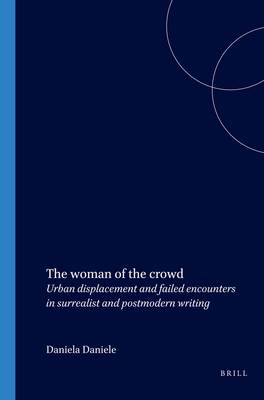
- Afhalen na 1 uur in een winkel met voorraad
- Gratis thuislevering in België vanaf € 30
- Ruim aanbod met 7 miljoen producten
- Afhalen na 1 uur in een winkel met voorraad
- Gratis thuislevering in België vanaf € 30
- Ruim aanbod met 7 miljoen producten
Zoeken
The Woman of the Crowd
Urban Displacement and Failed Encounters in Surrealist and Postmodern Writing
Daniela Daniele
€ 108,45
+ 216 punten
Omschrijving
This book traces the origins of the Postmodern eclectic grammar of linguistic collision back in the Surrealist poetics of ruins. Keeping in mind the images of lost direction in the big city as a central figure in the discussion of both the Modern and Postmodern aesthetics of displacement, Daniele starts comparing the epiphanic encounters of the Baudelairian flâneur in metropolitan Paris - in constant search for the traces of a lost symbolic order - with Breton's enigmatic pursuit of Nadja, the elusive sphinx in the crowd who moves in a mental territory of puzzling condensations and of ineffable objets trouvé. In his visual and written work, Marcel Duchamp was probably the first artist to envision the space of the crowd as a trans-urban, multiple dimension: a cool arena of disjunctive encounters contributing to transform the Surrealist erotic space of desire in a cooler, open field of performance.
Deeply influenced by Duchamp's hybrid aesthetics, American Postmodern writers such as Donald Barthelme and Thomas Pynchon, and the performance artist Laurie Anderson, represent metropolis as a "geographical incest", as a plural, entropic semiosphere which transcends the notion of urban community to become the tolerant receptacle of an ethnic and discoursive multiplicity, an electronic area of linguistic collisions translatable in new fragmented and unfinished narratives. Evoking the assemblages of Abstract Expressionists, the debris of Simon Rodia "junk art", and the hybrid language of Postmodern architecture, this neo-Surrealist narrative discourse transforms the epiphanic traces envisioned by the Baudelairian and Bretonian heroes in partial parodies, in enigmatic fragments whose ultimate source transcends the narrator's knowledge. The conceptual strategy which is constitutive of these texts implicitly asks the puzzled reader to disentangle the entropic plots, immerging him in the midst of a "linguistic wilderness," where all opposites - fact and fiction, man and machine, man and female - enigmatically and humorously coexist.
Deeply influenced by Duchamp's hybrid aesthetics, American Postmodern writers such as Donald Barthelme and Thomas Pynchon, and the performance artist Laurie Anderson, represent metropolis as a "geographical incest", as a plural, entropic semiosphere which transcends the notion of urban community to become the tolerant receptacle of an ethnic and discoursive multiplicity, an electronic area of linguistic collisions translatable in new fragmented and unfinished narratives. Evoking the assemblages of Abstract Expressionists, the debris of Simon Rodia "junk art", and the hybrid language of Postmodern architecture, this neo-Surrealist narrative discourse transforms the epiphanic traces envisioned by the Baudelairian and Bretonian heroes in partial parodies, in enigmatic fragments whose ultimate source transcends the narrator's knowledge. The conceptual strategy which is constitutive of these texts implicitly asks the puzzled reader to disentangle the entropic plots, immerging him in the midst of a "linguistic wilderness," where all opposites - fact and fiction, man and machine, man and female - enigmatically and humorously coexist.
Specificaties
Betrokkenen
- Auteur(s):
- Uitgeverij:
Inhoud
- Aantal bladzijden:
- 224
- Taal:
- Engels
- Reeks:
- Reeksnummer:
- nr. 28
Eigenschappen
- Productcode (EAN):
- 9789042012028
- Verschijningsdatum:
- 1/01/2000
- Uitvoering:
- Paperback
- Formaat:
- Trade paperback (VS)
- Afmetingen:
- 150 mm x 220 mm
- Gewicht:
- 376 g

Alleen bij Standaard Boekhandel
+ 216 punten op je klantenkaart van Standaard Boekhandel
Beoordelingen
We publiceren alleen reviews die voldoen aan de voorwaarden voor reviews. Bekijk onze voorwaarden voor reviews.








